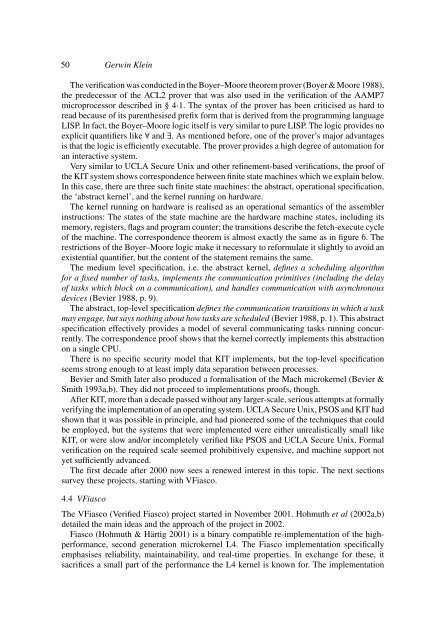Operating system verificationâAn overview
Operating system verificationâAn overview
Operating system verificationâAn overview
Create successful ePaper yourself
Turn your PDF publications into a flip-book with our unique Google optimized e-Paper software.
50 Gerwin Klein<br />
The verification was conducted in the Boyer–Moore theorem prover (Boyer & Moore 1988),<br />
the predecessor of the ACL2 prover that was also used in the verification of the AAMP7<br />
microprocessor described in § 4·1. The syntax of the prover has been criticised as hard to<br />
read because of its parenthesised prefix form that is derived from the programming language<br />
LISP. In fact, the Boyer–Moore logic itself is very similar to pure LISP. The logic provides no<br />
explicit quantifiers like ∀ and ∃. As mentioned before, one of the prover’s major advantages<br />
is that the logic is efficiently executable. The prover provides a high degree of automation for<br />
an interactive <strong>system</strong>.<br />
Very similar to UCLA Secure Unix and other refinement-based verifications, the proof of<br />
the KIT <strong>system</strong> shows correspondence between finite state machines which we explain below.<br />
In this case, there are three such finite state machines: the abstract, operational specification,<br />
the ‘abstract kernel’, and the kernel running on hardware.<br />
The kernel running on hardware is realised as an operational semantics of the assembler<br />
instructions: The states of the state machine are the hardware machine states, including its<br />
memory, registers, flags and program counter; the transitions describe the fetch-execute cycle<br />
of the machine. The correspondence theorem is almost exactly the same as in figure 6. The<br />
restrictions of the Boyer–Moore logic make it necessary to reformulate it slightly to avoid an<br />
existential quantifier, but the content of the statement remains the same.<br />
The medium level specification, i.e. the abstract kernel, defines a scheduling algorithm<br />
for a fixed number of tasks, implements the communication primitives (including the delay<br />
of tasks which block on a communication), and handles communication with asynchronous<br />
devices (Bevier 1988, p. 9).<br />
The abstract, top-level specification defines the communication transitions in which a task<br />
may engage, but says nothing about how tasks are scheduled (Bevier 1988, p. 1). This abstract<br />
specification effectively provides a model of several communicating tasks running concurrently.<br />
The correspondence proof shows that the kernel correctly implements this abstraction<br />
on a single CPU.<br />
There is no specific security model that KIT implements, but the top-level specification<br />
seems strong enough to at least imply data separation between processes.<br />
Bevier and Smith later also produced a formalisation of the Mach microkernel (Bevier &<br />
Smith 1993a,b). They did not proceed to implementations proofs, though.<br />
After KIT, more than a decade passed without any larger-scale, serious attempts at formally<br />
verifying the implementation of an operating <strong>system</strong>. UCLA Secure Unix, PSOS and KIT had<br />
shown that it was possible in principle, and had pioneered some of the techniques that could<br />
be employed, but the <strong>system</strong>s that were implemented were either unrealistically small like<br />
KIT, or were slow and/or incompletely verified like PSOS and UCLA Secure Unix. Formal<br />
verification on the required scale seemed prohibitively expensive, and machine support not<br />
yet sufficiently advanced.<br />
The first decade after 2000 now sees a renewed interest in this topic. The next sections<br />
survey these projects, starting with VFiasco.<br />
4.4 VFiasco<br />
The VFiasco (Verified Fiasco) project started in November 2001. Hohmuth et al (2002a,b)<br />
detailed the main ideas and the approach of the project in 2002.<br />
Fiasco (Hohmuth & Härtig 2001) is a binary compatible re-implementation of the highperformance,<br />
second generation microkernel L4. The Fiasco implementation specifically<br />
emphasises reliability, maintainability, and real-time properties. In exchange for these, it<br />
sacrifices a small part of the performance the L4 kernel is known for. The implementation
















